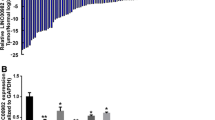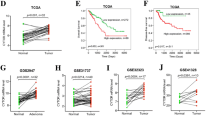Abstract
Background
Long intergenic non-coding RNA 460 (LINC00460) as a potential oncogene and Annexin A2 (ANXA2) as a promoter in different cancer progression processes was considered. A significant relationship between the LINC00460 and ANXA2 has been recently discovered in colorectal cancer (CRC). Therefore, defining molecular biomarkers accompanied by lesion histopathologic features can be a suggestive prognostic biomarker in precancerous polyps. This study aimed to investigate the elusive expression pattern of ANXA2 and LINC00460 in polyps.
Materials and methods
The construction of the co-expression and correlation network of LINC00460 and ANXA2 was plotted. LINC00460 and ANXA2 expression in 40 colon polyps was quantified by reverse transcription-real-time polymerase chain reaction. The receiver operating characteristic (ROC) curve was designed for distinguishing the high-risk precancerous lesion from the low-risk. Further, bioinformatics analysis was applied to find the shared MicroRNA-Interaction-Targets (MITs) between ANXA2 and LINC00460, and the associated pathways.
Results
ANXA2 has a high co-expression rank with LINC00460 in the lncHUB database. Overexpression of ANXA2 and LINC00460 was distinguished in advanced adenoma polyps compared to the adjacent normal samples. The estimated AUC for ANXA2 and LINC00460 was 0.88 − 0.85 with 93%-90% sensitivity and 81%-70% specificity. In addition, eight MITs were shared between ANXA2 and LINC00460. Enrichment analysis detected several GO terms and pathways, including HIF-1α associated with cancer development.
Conclusion
In conclusion, the expression of the ANXA2 and LINC00460 were significantly elevated in pre-cancerous polyps, especially in high-risk adenomas. Collectively, ANXA2 and LINC00460 may be administered as potential prognostic biomarkers in patients with a precancerous large intestine lesion as an alarming issue.







Similar content being viewed by others
Abbreviations
- CRC:
-
colorectal cancer
- HP:
-
hyperplastic polyp
- AP:
-
adenomatous polyp
- TP:
-
tubular adenoma polyp
- TVP:
-
tubulovillous polyp
- VP:
-
villus polyp
- HRA:
-
high-risk adenoma
- LRA:
-
low-risk adenoma
- lncRNAs:
-
long noncoding RNAs
- LINC00460:
-
long intergenic noncoding RNA 460
- MIT:
-
microRNA-interaction-target
- PPI:
-
protein-protein interaction
- BP:
-
biological process
- MF:
-
molecular functions
- CC:
-
cellular components
- EMT:
-
epithelial-mesenchymal transition
References
Xi Y, Xu P (2021) Global colorectal cancer burden in 2020 and projections to 2040. Translational Oncol 14(10):101174
Mamlouk S et al (2020) Malignant transformation and genetic alterations are uncoupled in early colorectal cancer progression. BMC Biol 18(1):1–16
Meseeha M, Attia M (2021) Colon polyps. StatPearls [Internet]
Turner KO, Genta RM, Sonnenberg A (2018) Lesions of all types exist in colon polyps of all sizes. Official J Am Coll Gastroenterology| ACG 113(2):303–306
Meester RG et al (2019) High-intensity versus low-intensity surveillance for patients with colorectal adenomas: a cost-effectiveness analysis. Ann Intern Med 171(9):612–622
Hajjar KA, Krishnan S (1999) Annexin II: a mediator of the plasmin/plasminogen activator system. Trends Cardiovasc Med 9(5):128–138
Huebner K et al (1988) Chromosomal localization of the human genes for lipocortin I and lipocortin II. Oncogene Res 2(4):299–310
Gurluler E et al (2014) Serum annexin A2 levels in patients with colon cancer in comparison to healthy controls and in relation to tumor pathology. Med Sci monitor: Int Med J experimental Clin Res 20:1801
Lokman NA et al (2011) The role of annexin A2 in tumorigenesis and cancer progression. Cancer Microenvironment 4(2):199–208
Hong W et al (2020) lncRNA LINC00460 silencing represses EMT in colon cancer through downregulation of ANXA2 via upregulating miR-433-3p Molecular Therapy-Nucleic Acids, 19: p. 1209–1218
Li T et al (2016) Molecular mechanisms of long noncoding RNAs on gastric cancer. Oncotarget 7(8):8601
Gutschner T, Diederichs S (2012) The hallmarks of cancer: a long non-coding RNA point of view. RNA Biol 9(6):703–719
Ponting CP, Oliver PL, Reik W (2009) Evolution and functions of long noncoding RNAs. Cell 136(4):629–641
Wu Q et al (2018) LncRNA MALAT1 induces colon cancer development by regulating miR-129‐5p/HMGB1 axis. J Cell Physiol 233(9):6750–6757
Rejali L et al (2021) Expression and clinical significance of Novel Long Noncoding RNA fibroblast growth factor 10AS and FGF10 in Colorectal Cancer. Cell J (Yakhteh) 23(6):665
Lian Y et al (2018) A novel lncRNA, LINC00460, affects cell proliferation and apoptosis by regulating KLF2 and CUL4A expression in colorectal cancer. Mol Therapy-Nucleic Acids 12:684–697
Li K et al (2018) Long non-coding RNA linc00460 promotes epithelial-mesenchymal transition and cell migration in lung cancer cells. Cancer Lett 420:80–90
Tang Z et al (2019) GEPIA2: an enhanced web server for large-scale expression profiling and interactive analysis. Nucleic Acids Res 47(W1):W556–w560
McGeary SE et al (2019) The biochemical basis of microRNA targeting efficacy. Science, 366(6472)
Chen Y, Wang X (2020) miRDB: an online database for prediction of functional microRNA targets. Nucleic Acids Res 48(D1):D127–d131
Huang H-Y et al (2021) miRTarBase update 2022: an informative resource for experimentally validated miRNA–target interactions. Nucleic Acids Res 50(D1):D222–D230
Szklarczyk D et al (2020) The STRING database in 2021: customizable protein–protein networks, and functional characterization of user-uploaded gene/measurement sets. Nucleic Acids Res 49(D1):D605–D612
Xie Z et al (2021) Gene Set Knowledge Discovery with Enrichr. Curr Protocols 1(3):e90
Wickham H (2016) Data analysis, in ggplot2. Springer. p. 189–201
Wang L et al (2020) Long noncoding RNA LINC00460 facilitates colorectal cancer progression by negatively regulating miR-613. OncoTargets and therapy 13:7555
Rocha MR et al (2018) Annexin A2 overexpression associates with colorectal cancer invasiveness and TGF-ss induced epithelial mesenchymal transition via Src/ANXA2/STAT3. Sci Rep 8(1):1–11
Wang T et al (2015) Anxa2 binds to STAT3 and promotes epithelial to mesenchymal transition in breast cancer cells. Oncotarget 6(31):30975
Yu H et al (2019) LncRNA LINC00461 promotes colorectal cancer progression via miRNA-323b-3p/NFIB axis OncoTargets and therapy, 12: p. 11119
Wei T-T et al (2020) Metabolic targeting of HIF-1α potentiates the therapeutic efficacy of oxaliplatin in colorectal cancer. Oncogene 39(2):414–427
Baba Y et al (2010) HIF1A overexpression is associated with poor prognosis in a cohort of 731 colorectal cancers. Am J Pathol 176(5):2292–2301
Ma S et al (2018) ANXA2 promotes esophageal cancer progression by activating MYC-HIF1A-VEGF axis. J Experimental Clin Cancer Res 37(1):183
Chen Z et al (2018) MiR-3662 suppresses hepatocellular carcinoma growth through inhibition of HIF-1α-mediated Warburg effect. Cell Death Dis 9(5):549
Li Z et al (2020) Identification of hub genes Associated with Hypertension and their Interaction with miRNA based on weighted gene coexpression network analysis (WGCNA) analysis. Med Sci Monit 26:e923514
Acknowledgements
The authors would like to thank all the staff of the Cancer Department in the Research Institute for Gastroenterology and Liver Diseases, Shahid Beheshti University of Medical Sciences, Tehran, Iran.
Funding
This project was completely supported and funded by the Gastroenterology and Liver Diseases Research Center, Research Institute for Gastroenterology and Liver Diseases, Shahid Beheshti University of Medical Sciences.
Author information
Authors and Affiliations
Contributions
Conceptualization FH, LR, MRZ, ZS, EDA, TT, NF, MH, HAA, ENM; Supervision ENM; Visualization FH, LR; Roles/Writing—original draft FH, LR, MRZ, ZS, EDA, TT; Writing—review & editing NF, MH, HAA, ENM. The work reported in the paper has been performed by the authors, unless clearly specified in the text.
Corresponding author
Ethics declarations
Competing interests
Farzaneh alsadat Hosseini, Leili Rejali, Mohammad Reza Zabihi, Zahra Salehi, Elahe Daskar Abkenar, Tanaz Traz, Nayeralsadat Fatemi, Mehrdad Hashemi, Hamid Asadzadeh Aghdaei, Ehsan Nazemalhosseini-Mojarad declare no relevant conflicts of interest. All authors contributed to the review and are responsible for the article content.
Ethics approval
This study was approved by the ethical committee (Ethics No. No.IR.IAU.PS.REC.1400.423) of the Islamic Azad University, Tehran, Iran.
Consent to participate
Informed consent was obtained from all individual participants included in the study.
Consent to publish
Not applicable to this article.
Additional information
Publisher’s Note
Springer Nature remains neutral with regard to jurisdictional claims in published maps and institutional affiliations.
Electronic supplementary material
Below is the link to the electronic supplementary material.
Rights and permissions
Springer Nature or its licensor (e.g. a society or other partner) holds exclusive rights to this article under a publishing agreement with the author(s) or other rightsholder(s); author self-archiving of the accepted manuscript version of this article is solely governed by the terms of such publishing agreement and applicable law.
About this article
Cite this article
Hosseini, F.A., Rejali, L., Zabihi, M.R. et al. Long non‑coding RNA LINC00460 contributes as a potential prognostic biomarker through its oncogenic role with ANXA2 in colorectal polyps. Mol Biol Rep 50, 4505–4515 (2023). https://doi.org/10.1007/s11033-023-08393-6
Received:
Accepted:
Published:
Issue Date:
DOI: https://doi.org/10.1007/s11033-023-08393-6




